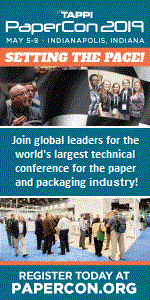| |
 · www.tappi.org
· www.tappi.org
· Subscribe
to Ahead of the Curve
· Newsletters
· Ahead
of the Curve archived issues
· Contact
the Editor

|
|
|
|
Meet the Program Leaders:
Todd Varner on Staying Competitive
The success of TAPPI's annual PaperCon event is largely due to the working professionals who plan the technical program. These volunteer leaders rely on their industry experience to create a program that actively addresses the critical issues attendees face on their jobs every day. We're pleased to offer a series of interviews with these leaders, to bring their expertise to a wider audience through Ahead of the Curve.
Todd Varner is process engineering department manager, Jacobs, and serves on the Papermakers Planning Committee. He holds a Master of Science focused in Pulp & Paper Science from Institute of Paper Science & Technology.
TAPPI: What do you feel are the most critical issues facing the industry today? What issues specifically affect mills and what resources are available to help those mills?
VARNER: How to right size everything—how to match production with demand and how to forecast that demand two, three, four, or even 10 years down the road. At Jacobs, we help paper mills take the assets they have today and convert them, maintain them, and improve them. Yet I think a lot of companies are afraid to look too far into the future when developing their market strategy because things are changing so much. How far one can forecast is really a problem for many executives in the paper industry.
Are you finding that five years is a lot? Ten years?
Yes. In my opinion, you really cannot see much more than four to five years. I am not a marketing person—I'm an engineer who gets affected by the marketing side of the business. We're always asking ourselves, "which product should we make?"
I don't think many people foresaw the growth of the Amazon titan business model. Just a few decades ago we saw a lot of packaging grades decline, but that has turned around completely. Printing and writing papers are on a slow decline, though not as fast as people thought. Is that going to continue? Will it hit bottom? Is there a new material that we will see coming out in the next five to 10 years that will allow us to use fiber to 3-D print things? I think that is the type of challenge we have moving forward. How do we best use the assets we have for the future?
What do mills need to do today to remain competitive in the future?
First of all, they need to optimize the assets they have and not accept the status quo of "we did this yesterday" or "that is the way we have always done it." Secondly, they need to understand their niche and their strengths and build on that strength. They also need to understand their weaknesses. Is their weakness cost of production, or is their weakness reliability? Are these just impacts they live with? Mills need to improve the overall productivity of their system. Each mill needs to understand that.
Energy is another concern. Some paper mills waste energy because energy is so cheap—but that's another area mills can start to focus on. PaperCon usually features a track on energy improvement, and there is one planned for 2019 too.
What have been some of the greatest challenges you have faced in your position and what resources did you use to overcome those challenges?
Actually, I face both technical and business challenges. We have all kinds of resources to address the technical challenges—including TAPPI TIPs and other papers you can find online. A lot of times the technical questions people have are already answered, at least in part; so instead of reinventing the wheel, we can reach out and grab those resources.
For example, one TAPPI TIP offers a detailed description of the things you need to do around the vetting of a paper machine and the design of the stock approach system. It's a great resource for me personally, and I keep a printed copy with me all the time because it tells me "In this section of the machine, these are the parameters you need." Also, attending PaperCon allows people to network and discover who they can go to for this type of question. That's on the technical side.
On the "people" side, going to PaperCon—especially presenting and sharing what you have done—will help your public speaking ability and your interpersonal communication. It also helps you build a network in the industry. The paper industry is so small that people can make those connections over and over again and really increase the cross-linking that gives professionals longevity in their careers and business.
What are some key industry trends and issues that will be addressed at PaperCon?
One thing we're focusing on this year is paper machine conversions. How do you take the assets you have today and project those into the future? What markets will need more products? How do you marry the equipment you have, the fiber source you have, and the people you have with where the markets are going? How far down can you project that? Everything is changing. We're using less print materials but more packaging materials, for instance—we can see that trend.
In the Papermaking Conversions track, we are focusing on how to take those same resources—equipment, facilities, and the people and their talent—and convert and manage them to a new product. How do you best meet the demands of tomorrow with the equipment you have today?
Your team has attended PaperCon in the past. How has PaperCon helped you and your company achieve your goals?
We've been involved with PaperCon for a long time. Usually one or two people from our organization go each year but we've increased that focus lately to achieve a couple of things. One is to showcase what we've been able to do as a company and say, "Here are some things that we've learned that we'll share with everybody else." It also helps us make networking contacts. As a consultant, we need those contacts to even have a business; our business sells our knowledge and ability. PaperCon allows us to not only share what we have learned but also to highlight the people who have learned it. Our company doesn't make paper but we help paper companies do it better.
Why do you feel mills and other paper professionals need to attend PaperCon 2019?
PaperCon 2019 in Indianapolis is really going to help mills thinking about paper machine conversion. The conference will address solutions they need to consider as well as some things people might forget—such as quality control, drying, and pressing. PaperCon will really offer details there.
Also, mill folks will have a chance to talk to other folks that have already been through conversions and have stumbled through some things. They can learn from those mistakes as well as the successes. I think this year's Papermaking Track will highlight many things mills need to do if they're considering a conversion. If they are considering just staying where they are and optimizing, there are quite a few sessions on that as well.
What is one word you would use to describe PaperCon?
Family. PaperCon is like a family reunion in the way that, as an industry, we can come together to share our learnings and successes.
PaperCon will take place May 5-8 in Indianapolis, IN. Visit www.papercon.org for program details, special registration rates for mills, travel information, and more.
For a modest investment of $174, receive more than US$ 1000 in benefits in return.
Visit www.tappi.org/join for more details. |
|




